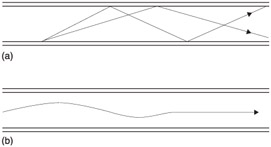3.2 Types of Transmission Channel
| | ||
| | ||
| | ||
3.2 Types of Transmission Channel
Transmission can be by electrical conductors, radio or optical fibre. Although these appear to be completely different, they are in fact just different examples of electromagnetic energy travelling from one place to another. If the energy is made time-variant, information can be carried.
Electromagnetic energy propagates in a manner that is a function of frequency, and our incomplete understanding requires it to be considered as electrons, waves or photons so that we can predict its behaviour in given circumstances.
At DC and at the low frequencies used for power distribution, electromagnetic energy is called electricity and needs to be transported completely inside conductors. It has to have a complete circuit to flow in, and the resistance to current flow is determined by the cross-sectional area of the conductor. The insulation around the conductor and the spacing between the conductors has no effect on the ability of the conductor to pass current. At DC an inductor appears to be a short circuit, and a capacitor appears to be an open circuit.
As frequency rises, resistance is exchanged for impedance. Inductors display increasing impedance with frequency, capacitors show falling impedance. Electromagnetic energy increasingly tends to leave the conductor. The first symptom is the skin effect: the current flows only in the outside layer of the conductor effectively causing the resistance to rise.
As the energy is starting to leave the conductors, the characteristics of the space between them become important. This determines the impedance. A change of impedance causes reflections in the energy flow and some of it heads back towards the source. Constant impedance cables with fixed conductor spacing are necessary, and these must be suitably terminated to prevent reflections. The most important characteristic of the insulation is its thickness as this determines the spacing between the conductors.
As frequency rises still further, the energy travels less in the conductors and more in the insulation between them, and their composition becomes important and they begin to be called dielectrics. A poor dielectric like PVC absorbs high-frequency energy and attenuates the signal. So-called low-loss dielectrics such as PTFE are used, and one way of achieving low loss is to incorporate as much air into the dielectric as possible by making it in the form of foam or extruding it with voids.
High-frequency signals can also be propagated without a medium, and are called radio. As frequency rises further the electromagnetic energy is termed 'light' which can also travel without a medium, but can also be guided through a suitable medium. Figure 3.1(a) shows an early type of optical fibre in which total internal reflection is used to guide the light. It will be seen that the length of the optical path is a function of the angle at which the light is launched. Thus at the end of a long fibre sharp transitions would be smeared by this effect. Later optical fibres are made with a radius-dependent refractive index such that light diverging from the axis is automatically refracted back into the fibre. Figure 3.1(b) shows that in single-mode fibre light can only travel down one path and so the smearing of transitions is minimized.

Figure 3.1: (a) Early optical fibres operated on internal reflection, and signals could take a variety of paths along the fibre, hence multi-mode. (b) Later fibres used graduated refractive index whereby light was guided to the centre of the fibre and only one mode was possible.
| | ||
| | ||
| | ||
EAN: 2147483647
Pages: 120